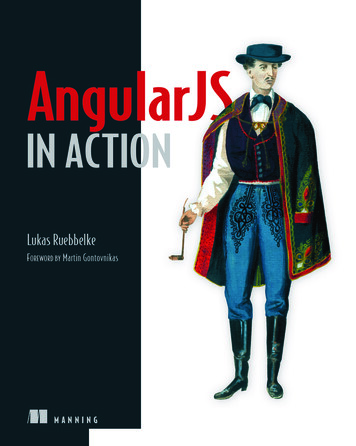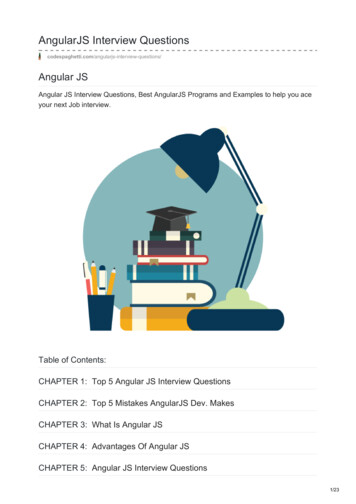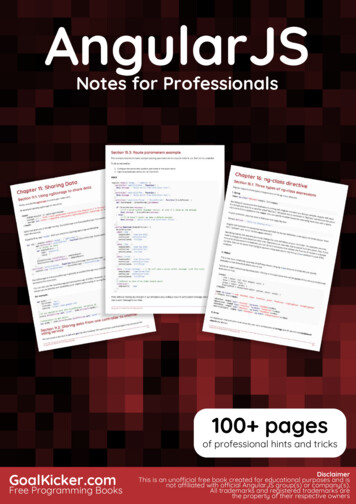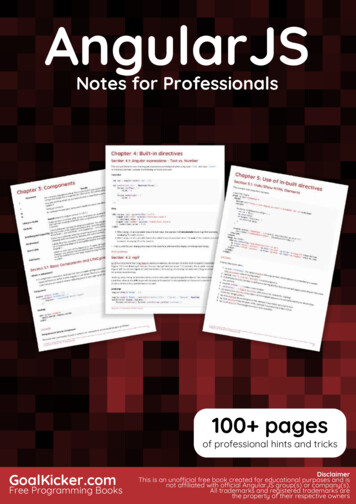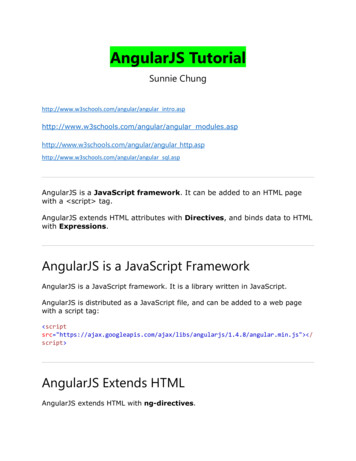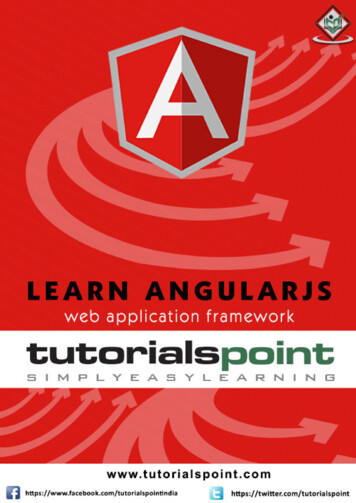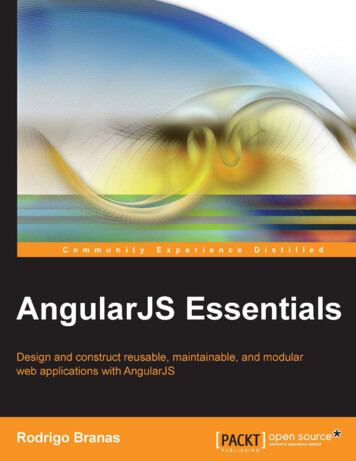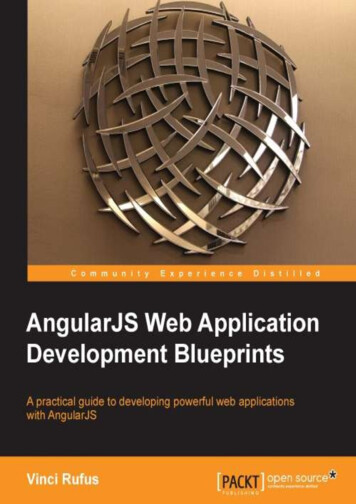
Transcription
www.allitebooks.com
PhoneGap and AngularJS forCross-platform DevelopmentBuild exciting cross-platform applications usingPhoneGap and AngularJSYuxian, Eugene LiangBIRMINGHAM - MUMBAIwww.allitebooks.com
PhoneGap and AngularJS for Cross-platformDevelopmentCopyright 2014 Packt PublishingAll rights reserved. No part of this book may be reproduced, stored in a retrievalsystem, or transmitted in any form or by any means, without the prior writtenpermission of the publisher, except in the case of brief quotations embedded incritical articles or reviews.Every effort has been made in the preparation of this book to ensure the accuracyof the information presented. However, the information contained in this book issold without warranty, either express or implied. Neither the author, nor PacktPublishing, and its dealers and distributors will be held liable for any damagescaused or alleged to be caused directly or indirectly by this book.Packt Publishing has endeavored to provide trademark information about all of thecompanies and products mentioned in this book by the appropriate use of capitals.However, Packt Publishing cannot guarantee the accuracy of this information.First published: October 2014Production reference: 1241014Published by Packt Publishing Ltd.Livery Place35 Livery StreetBirmingham B3 2PB, UK.ISBN 978-1-78398-892-1www.packtpub.comCover image by Aniket Sawant (aniket sawant photography@hotmail.com)[ FM-2 ]www.allitebooks.com
CreditsAuthorProject CoordinatorYuxian, Eugene LiangKartik VedamReviewersProofreadersSimon BassetMaria GouldRazi MahmoodElinor Perry-SmithCommissioning EditorIndexersKunal ParikhMonica Ajmera MehtaTejal SoniAcquisition EditorMeeta RajaniProduction CoordinatorsKyle AlbuquerqueContent Development EditorPriyanka ShahNilesh R. MohiteCover WorkTechnical EditorsNilesh R. MohiteVeronica FernandesAnand SinghCopy EditorsRoshni BanerjeeAdithi Shetty[ FM-3 ]www.allitebooks.com
About the AuthorYuxian, Eugene Liang is a frontend engineer with working knowledge of UXand data mining / machine learning. He builds applications predominantly usingJavaScript/Python, and related frameworks such as AngularJS, ReactJS, Node.js, Tornado, and Django. He led a team of two (including himself) to win StartupWeekend at Taiwan recently. He has also completed academic research on socialnetwork analysis (link prediction) using machine learning techniques, whileinterning as a frontend engineer at Yahoo!. To know more about him, visithttp://www.liangeugene.com.I am grateful for this opportunity and I want to thank the followingpeople at Packt Publishing: Priyanka Shah, Kartik Vedam, SageerParkar, Meeta Rajani, and Anand Singh.Special thanks to Professor Daphne Yuan, Professor Tsai-Yen Li,and Professor Pailin Chen of the National Cheng Chi University,Taipei, Taiwan, for providing me with timely and practical adviceon how to carry out great research and how to deal with life.To the good people of Service Science Research Center, IntelligentMedia Lab, and the research team of the Flood and Fire researchproject, thank you for helping me out when I needed it the most.I also want to thank XJL for helping me out and staying put whenI most needed support.Last but not least, I want to thank my family members and friendsfor their continued support.[ FM-4 ]www.allitebooks.com
About the ReviewersSimon Basset is a cross-platform mobile and frontend engineer living in Paris.He works hard every day to create attractive mobile and web apps.He worked for years at Smile Open Source Solutions, technically leading a teamspecializing in mobile development, and has recently joined the frontend expertteam of AXA France.He is a technology enthusiast. He likes to try and use cutting-edge technologiesand loves the Web and open source. He also loves animals, has two cats, and isa vegetarian.Razi Mahmood has a Master's degree in IT with 14 years of working experience,and is an accomplished and experienced software training consultant. His interestin technology never fades and he always keeps himself updated with the latesttechnology. As a result, he has succeeded in many areas in his career. He is motivatedand is a quick learner, and has the ability to handle projects with minimumsupervision; these are his personal strengths in every achievement.Razi started his career as an executive in an engineering firm in Kuala Lumpur. Overthe years, he has developed custom software solutions to expedite work in accounting,human resources, and project management reporting. These solutions were eventuallydocumented and presented as part of his project thesis for his Master's degree. Uponcompletion of his Master's degree, he joined the School Of Technology Management,Binary University as a lecturer in Software Engineering and Accounting InformationSystem. Since then, he has supervised various application development projectsundertaken by students using various platforms such as Windows, Linux, OS X,Android, and iOS. In 2008, he was appointed as a member of the Panel of Assessorsof Malaysian Quality Assurance Programme, specializing in databases. He is also aco-developer for an education-based mobile apps project endorsed by the MalaysianMinistry Of Education to help students learn local history subjects. This app isnow featured on Google's Play store (https://play.google.com/store/apps/details?id com.fiziazezan2gmail.com.ism2&hl en).[ FM-5 ]www.allitebooks.com
www.PacktPub.comSupport files, eBooks, discount offers, and moreYou might want to visit www.PacktPub.com for support files and downloads relatedto your book.Did you know that Packt offers eBook versions of every book published, with PDFand ePub files available? You can upgrade to the eBook version at www.PacktPub.comand as a print book customer, you are entitled to a discount on the eBook copy. Get intouch with us at service@packtpub.com for more details.At www.PacktPub.com, you can also read a collection of free technical articles,sign up for a range of free newsletters and receive exclusive discounts and offerson Packt books and eBooks.TMhttp://PacktLib.PacktPub.comDo you need instant solutions to your IT questions? PacktLib is Packt's onlinedigital book library. Here, you can access, read and search across Packt's entirelibrary of books.Why subscribe? Fully searchable across every book published by PacktCopy and paste, print and bookmark contentOn demand and accessible via web browserFree access for Packt account holdersIf you have an account with Packt at www.PacktPub.com, you can use this to accessPacktLib today and view nine entirely free books. Simply use your login credentialsfor immediate access.[ FM-6 ]www.allitebooks.com
Table of ContentsPrefaceChapter 1: Introduction to AngularJSA brief overview of AngularJSCore conceptsControllersData-bindingDirectivesA conceptual exampleA simple to-do list using AngularJSPreparing your code structureHTML for our to-do listAdding in JavaScript with AngularJSSummaryChapter 2: Getting Ready for PhoneGapPreparing for PhoneGap developmentInstalling AndroidInstalling iOSCommand-line interface for both Android and iOSRunning on real devicesAngularJS on PhoneGapWhat just happened?Creating a to-do list app using AngularJS on PhoneGapA basic version of a to-do list using AngularJS on 717181818202126262631
Table of ContentsChapter 3: From a Simple To-do List to an Advanced To-do List33Chapter 4: Adding Authentication Capabilities UsingPhoneGap Plugins57Chapter 5: Sprucing Up the App Using Animations andMobile Design81Rewriting the simple to-do list appSplitting index.html into multiple filesSplitting todo.js into multiple filesCheckpointWiring up a backend serverCoding our serverChanging AngularJS to perform RESTful requestsUsing the http module of AngularJSRewriting controllers to make use of the http moduleChecking our codePreparing for PhoneGapTesting our code on iOSTesting our code on AndroidSummaryAdding Facebook Connect to the to-do list appInitializing and preparing for Facebook ConnectWriting the user controllerAdding a login pageAdding a logout functionChecking the login statusFacebook login for PhoneGapInstalling the Facebook pluginTesting out Facebook Login on PhoneGapFrom web to PhoneGapImporting Facebook and PhoneGap pluginsChanging FB to facebookConnectPluginThe to-do list app with Facebook Login on PhoneGapSummaryAdding animations to your web appAdding mobile CSS styles to your appPorting your web app to PhoneGapTesting your app on iOSTesting your app on AndroidSummary[ ii 58596063656767707475777880818588909191
Table of ContentsChapter 6: Getting Ready to LaunchDeploying server.pyUsing phonegap.comPreparing your PhoneGap app for an Android releaseTesting your app on real devicesExporting your app to install on other devicesPreparing promotional artwork for releaseBuilding your app for releaseSigning the appiOSRunning your app on an iOS deviceOther techniquesUsing XcodeSummary93939596969697979798989999101Appendix: References103Index105AngularJS and related librariesPhoneGap and related referencesOthersOther tutorials103103104104[ iii ]www.allitebooks.com
PrefaceWelcome to AngularJS with PhoneGap! In this book, you will receive practicalknowledge about AngularJS and PhoneGap. In particular, you will learn how tobuild a complete, workable web app using AngularJS, after which you will convertvarious versions of this web app to a PhoneGap app. You should also pick upsomething new regarding PhoneGap in particular: how to use the command-lineinterface to generate PhoneGap apps.What this book coversChapter 1, Introduction to AngularJS, will teach you the absolute basics of building anAngularJS app.Chapter 2, Getting Ready for PhoneGap, will cover the PhoneGap command-lineinterface. By end of this chapter, you will have learned that the command-lineinterface is one of the best things about PhoneGap 3.x. The example you codedin Chapter 1, Introduction to AngularJS, will be put to use in this chapter.Chapter 3, From a Simple To-do List to an Advanced To-do List, will cover some ofthe slightly more advanced concepts of AngularJS, such as code organization,making RESTful calls, and more. This advanced app will then be converted toa PhoneGap app.Chapter 4, Adding Authentication Capabilities Using PhoneGap Plugins, will add Facebookauthentication capabilities via PhoneGap plugins. Once again, you will see how wecan add the Facebook plugin using the command-line interface.Chapter 5, Sprucing Up the App Using Animations and Mobile Design, will cover aslightly more advanced AngularJS topic: animations.Chapter 6, Getting Ready to Launch, will teach you how to launch the app, both inAndroid and iOS devices.Appendix, References, has a list of references that you should find useful.
PrefaceWhat you need for this bookThis book assumes that you have a basic code editor. You will need a Mac if youintend to develop iOS versions of the PhoneGap app. You will most definitelyrequire an Internet connection and the Google Chrome browser.Who this book is forThis book is intended for people who are not familiar with AngularJS but havebeginner experience in PhoneGap, and who might want to improve their PhoneGapskills by learning the command-line interface for PhoneGap 3.x, and developPhoneGap apps using AngularJS.ConventionsIn this book, you will find a number of styles of text that distinguish betweendifferent kinds of information. Here are some examples of these styles, and anexplanation of their meaning.Code words in text, database table names, folder names, filenames, file extensions,pathnames, dummy URLs, user input, and Twitter handles are shown as follows:"Feel free to copy the code and save it as concepts.html."A block of code is set as tml[2]
PrefaceWhen we wish to draw your attention to a particular part of a code block, the relevantlines or items are set in bold: li ng-repeat "todo in todos" input type "checkbox" ng-model "todo.done" span class "done-{{todo.done}}" {{todo.text}} /span button ng-click "showDetail(todo.text)" Detail /button /li Any command-line input or output is written as follows:cordova emulate androidNew terms and important words are shown in bold. Words that you see on thescreen, in menus or dialog boxes for example, appear in the text like this: "Click onEdit/Details for the Android item and start editing."Warnings or important notes appear in a box like this.Tips and tricks appear like this.Reader feedbackFeedback from our readers is always welcome. Let us know what you think aboutthis book—what you liked or may have disliked. Reader feedback is important forus to develop titles that you really get the most out of.To send us general feedback, simply send an e-mail to feedback@packtpub.com,and mention the book title via the subject of your message.If there is a topic that you have expertise in and you are interested in either writingor contributing to a book, see our author guide on www.packtpub.com/authors.Customer supportNow that you are the proud owner of a Packt book, we have a number of things tohelp you to get the most from your purchase.[3]
PrefaceDownloading the example codeYou can download the example code files for all Packt books you have purchased fromyour account at http://www.packtpub.com. If you purchased this book elsewhere,you can visit http://www.packtpub.com/support and register to have the filese-mailed directly to you.ErrataAlthough we have taken every care to ensure the accuracy of our content, mistakesdo happen. If you find a mistake in one of our books—maybe a mistake in the text orthe code—we would be grateful if you would report this to us. By doing so, you cansave other readers from frustration and help us improve subsequent versions of thisbook. If you find any errata, please report them by visiting http://www.packtpub.com/submit-errata, selecting your book, clicking on the errata submission form link,and entering the details of your errata. Once your errata are verified, your submissionwill be accepted and the errata will be uploaded on our website, or added to any list ofexisting errata, under the Errata section of that title. Any existing errata can be viewedby selecting your title from http://www.packtpub.com/support.PiracyPiracy of copyright material on the Internet is an ongoing problem across all media.At Packt, we take the protection of our copyright and licenses very seriously. If youcome across any illegal copies of our works, in any form, on the Internet, pleaseprovide us with the location address or website name immediately so that we canpursue a remedy.Please contact us at copyright@packtpub.com with a link to the suspectedpirated material.We appreciate your help in protecting our authors, and our ability to bring youvaluable content.QuestionsYou can contact us at questions@packtpub.com if you are having a problem withany aspect of the book, and we will do our best to address it.[4]
Introduction to AngularJSWelcome to the world of AngularJS with PhoneGap! In this book, you will learnhow to merge two very exciting technologies, namely AngularJS and PhoneGap. Bythe end of this book, you will have a working mobile app that works across iOS andAndroid, based on AngularJS and PhoneGap. As mentioned previously, this bookis targeted at programmers who have knowledge of PhoneGap, but may or may nothave knowledge regarding AngularJS. You should have some idea about JavaScriptthough, for you to get maximum benefit out of this book. That said, let us beginwith AngularJS.A brief overview of AngularJSAngularJS (https://angularjs.org/) is a super heroic JavaScript MVC framework,which is maintained by Google. It is open source and its main goal is to assist withcreating single page applications. These are typically one-page web applications thatonly require HTML, CSS, and JavaScript on the client side.While one may argue that there are already many frameworks out there in themarket that help with this issue, I would like to say that AngularJS is different in afew ways. And in quite a few of these instances, it makes your life much easier asa frontend programmer.Core conceptsThere are many concepts related to AngularJS, but I will cover the most commonlyused ones for the sake of progressing through this chapter. As we go along in thisbook, I'll touch on other concepts, such as the use of self-defined directives andperforming RESTful requests via AngularJS. The main concepts that you shouldunderstand in this section are directives, controllers, and data binding.
Introduction to AngularJSControllersIf you have already used JavaScript frameworks, such as BackBone.js, Can.js, Ember.js,or KnockOut.js, you should be familiar with this concept. Controllers are the behaviorbehind the DOM elements. AngularJS lets you express the behavior in a clean readableform without the usual boilerplate of updating the DOM, registering callbacks, orwatching model changes.Data-bindingData-binding is an automatic way to update the view whenever the model changes,as well as updating the model whenever the view changes. The coolest aspect of thisconcept is that it is a two way data-binding process. Used in tandem with controllers,this can save you a lot of code, as there is no need for you to write the usual updatingof the DOM elements.DirectivesDirectives are another awesome concept in AngularJS. What they do is teachyour application new HTML syntax and new things specific to your application.Directives can be self-defined and predefined. Some of the more notablepredefined directives include: ng-app: This declares an element as a root element of the application, ng-bind: This automatically changes the text of an HTML element to thevalue of a given expression. ng-model: This is similar to ng-bind, but allows two-way binding between ng-controller: This specifies a JavaScript controller class, which evaluatesHTML expressions. In layman's terms, what ng-controller does is that itallowing its behavior to be modified through custom HTML tags.the view and scope.applies a JavaScript function to this block of HTML so that this particularJavaScript function (including its accompanying logic, expressions, andmore) can only operate in this block of HTML. ng-repeat: You can see this as a loop through a collection.[6]
Chapter 1A conceptual exampleNow, let's take a look at how some of the previous concepts play together.Consider the following piece of code: !doctype html html ng-app head script src .2.12/angular.min.js" /script /head body div label Say Hello World /label input type "text" ng-model "yourHelloWorld" placeholder "Typeanything here." hr h1 Hello {{yourHelloWorld}}! /h1 /div /body /html Downloading the example codeYou can download the example code files for all Packt books you havepurchased from your account at http://www.packtpub.com. If youpurchased this book elsewhere, you can visit http://www.packtpub.com/support and register to have the files e-mailed directly to you.Let's go through the code. We defined an HTML5 HTML document in this case, as seen in the first line Next, notice ng-app in the second line of the code; this is anAngularJS directive, which tells AngularJS that this is the root of theAngularJS application In order to use AngularJS, we obviously have to install the script onthis web page, as shown in the script tag Within the body tag, we see a label, an input, and an h1 tag. Take note of the input tag, there is a ng-model directive, which is mappedto h1 tag's {{yourHelloWorld}} What the previous piece of code does is that anything that is typed intothe input box, will be shown in place of {{yourHelloWorld}}Take note of the version of the code we are using in this chapter, version 1.2.12;should you be using newer versions of AngularJS, there is no guarantee that thecode will work.[7]
Introduction to AngularJSNow that we have briefly walked through the code, let us copy the code and run it onour web browser. Feel free to copy the code and save it as concepts.html. The sourcecode for this chapter can be found in the concepts.html file in the Chapter 1 folder.Copied the code? If so, open the file in your favorite web browser. You should seethe following screenshot in your browser:A sample concept web pageGot the previous code? Ok great! So now you can try typing into the input box andsee new text being appended to Hello and before ! in the screen.For instance, when we type world, we will see the new characters being appendedto the screen as I continue to type. By the end of typing the word "World", we shouldsee the following screenshot:After typing WorldNow that we have a brief idea as to how a simple AngularJS app works, let us moveto a more complicated app.A simple to-do list using AngularJSIn this example, we will cover in detail as to how to write code for a slightly morecomplicated AngularJS app. This app is modified from the official example found atangularjs.org. This example will be used as a base when we convert it from a webapplication to a PhoneGap application.[8]
Chapter 1Preparing your code structureFor starters, create the index.html and todo.js files. Just for your information,the code found in this section can be found in the todo folder in Chapter 1.HTML for our to-do listWe need to prepare our HTML file so that we can make use of AngularJS. Similar tothe previous concepts.html file, you will see that we have included the use ofAngularJS via script. Open up your index.html file in your favorite editor and youcan start by adding the following code: !doctype html html ng-app head script src .2.12/angular.min.js" /script script src "todo.js" /script link rel "stylesheet" href s/bootstrap.min.css" style body {padding:40px;}#todoDetails {visibility: hidden;} /style /head body div class "row" ng-controller "todoCtrl" div class "col-md-6" h2 Todo /h2 div span {{getRemaining()}} of {{todos.length}} remaining /span [ button ng-click "archive()" archive /button ] ul class "unstyled" li ng-repeat "todo in todos" input type "checkbox" ng-model "todo.done" span class "done-{{todo.done}}" {{todo.text}} /span button ng-click "showDetail(todo.text)" Detail /button /li /ul form ng-submit "addTodo()" [9]
Introduction to AngularJS input type "text" ng-model "todoText" size "30"placeholder "add new todo here" input class "btn-primary" type "submit" value "add" /form /div /div div id "todoDetails" class "col-md-6" h2 Details /h2 Title: span id "title" {{currentText}} /span br Add Details: form ng-submit "addDetails()" textarea id "details" ng-model "currentDetails" {{currentDetails}} /textarea p input class "btn-primary" type "submit" value "AddDetails" input class "btn-primary" type "submit" value "Cancel" ngclick "closeThis()" /p /form /div /div /body /html Now, to make sure that you are on the same page as I am, I want you to open this filein your favorite browser. You should see something like the following screenshot:Our HTML template[ 10 ]
Chapter 1Got the previous code? It looks weird now due to the fact that we have not added themain JavaScript functionalities. We will be working on it in the next section.Now, let me explain the code; notice that I have highlighted a few lines of it. Theseare the most important lines of the code that you should take note of in this example.The remaining lines are just the usual HTML code. The first two lines of the highlighted code simply install AngularJS andinclude BootStrap 3's CSS for styling purposes. Without both, the projectwill not work and may not look good. The ng-controller directive is what we covered briefly earlier on in thischapter. We are applying todoCtrl to this block of HTML. The ng-click directive is another directive that we did not touch on in theprevious section. What ng-click does is that it executes whatever functionis defined for this directive. In our example, ng-click "archive()" meansthat on clicking it, archive() will be executed. The JavaScript functionarchive() is written in our todo.js file, which we will cover later. The ng-repeat directive is a directive that loops through a collection.Notice how we implemented ng-repeat in our HTML code: li ng-repeat "todo in todos" input type "checkbox" ng-model "todo.done" span class "done-{{todo.done}}" {{todo.text}} /span button ng-click "showDetail(todo.text)" Detail /button /li Anything that is within li is dependent on the todo object, which is partof the todos collection. The ng-submit directive is generally used in forms. This is a directive whichcontrols what is being done on the submit form. In this case, on the submitform, we will execute the JavaScript function addToDo(). The [] option encapsulates button ng-click "archive()" archive /button , which simply adds a square bracket around the button.Adding in JavaScript with AngularJSNow we will open our todo.js file, which we created in the previous section.Open todo.js in your favorite text editor. Let us begin by coding the following:function todoCtrl( scope) {}[ 11 ]
Introduction to AngularJSWe are first going to define a controller, which we will be using for our app. Noticethat we have named it todoCtrl, which is mapped onto ng-controller in theHTML file (index.html), where ng-controller "todoCtrl" means that todoCtrlwill be controlling this portion of the web page.Also, notice the use of scope, which is an object that refers to the application model;it is the execution context for related expressions, such as ng-click, ng-model,and so on. Any such expressions of a predefined directive outside this scope willnot be executed.Let's start by initializing our to-do list. Within todoCtrl, add the following code: scope.todos [{text:'here is my first to do', done:true, details:''},{text:'continue writing chapter 1 for this book', done:false,details:''},{text:'work on chapter 2 examples', done:false, details:''}]; scope.currentText ''; // make the text empty scope.currentDetails ''; // make the text emptyWhat scope.todos does is that it simply creates a list of objects, which containsthe text, details, and whether this to-do is executed or not (true or false). Noticethat todos here is mapped to the collection todos as seen in index.html, whereng-repeat is being used.Let's move on by adding more functionalities. After scope.currentDetails,add the following three JavaScript functions: scope.addTodo function() { scope.todos.push({text: scope.todoText, done:false, details:''}); scope.todoText '';}; scope.remaining function() {var count 0;angular.forEach( scope.todos, function(todo) {count todo.done ? 0 : 1;});return count;}; scope.archive function() {var oldTodos scope.todos; scope.todos [];[ 12 ]
Chapter 1angular.forEach(oldTodos, function(todo) {if (!todo.done) scope.todos.push(todo);});};The scope.todoText function resets todoText after it has been pushed into thearray. The scope.addTodo function does what it is suppose to do, simply addinga new to-do to the list of todos as defined earlier. The beauty of AngularJS is that ituses standard JavaScript data structures that make manipulation so much easier.The scope.getRemaining function simply calculates the number of items thatare not done yet. Here, we can see two-way data-binding in action as this functionexecutes whenever there is a change in the length of todos.The scope.archive function marks a to-do as done:true in standardJavaScript manner.By now, you should have noticed that all the JavaScript functions defined here arebeing used in index.html under ng-controller "todoCtrl".Let's now add three more JavaScript functions to complete the finishing touch forthis sample application.After the scope.archive function, add the following functions: scope.showDetail function(text) {var result scope.todos.filter(function (obj) {return obj.text text;}) scope.currentText result[0].text; scope.currentDetails ails').style.visibility 'visible';} scope.closeThis function() { scope.currentText ''; scope.currentDetails sibility 'hidden';} scope.addDetails function(text) {var result scope.todos.filter(function (obj) {return obj.text text;})[ 13 ]
Introduction to AngularJSangular.forEach( scope.todos, function(todo) {if(todo.text text) {todo.details todoDetails').style.visibility 'hidden';}The scope.showDetail function simply retrieves the current to-do being clicked onand shows it on the div with ID #todoDetails. The visibility of the #todoDetailsfunction is then set to visible.The scope.close function simply changes the visibility of #todoDetails to hidden.Finally, scope.addDetails adds the details of the todo item, and changes thevisibility of #todoDetails to hidden once done.Okay, so to see if we are on the same page, we now need to check our code. Savethis file as todo.js. Refresh your browser and you should still see the same userinterface as per the previous screenshot.Now, try clicking on the Detail button in front of work on chapter 2 examples,and you should see the following screenshot:Details of the ToDo item shows on clicking on the corresponding detail buttonYou will see the details of a particular to-do item. You can try to add some details forthis item and click on Add Details. You can then click on other items and come backto this item later (without refreshing the browser), and you should still see the detailsin the text area.[ 14 ]
Chapter 1You can also check off any of the items and y
Welcome to AngularJS with PhoneGap! In this book, you will receive practical knowledge about AngularJS and PhoneGap. In particular, you will learn how to build a complete, workable web app using AngularJS, after which you will convert various versions of this web app to a PhoneGap app. You should also pick up
